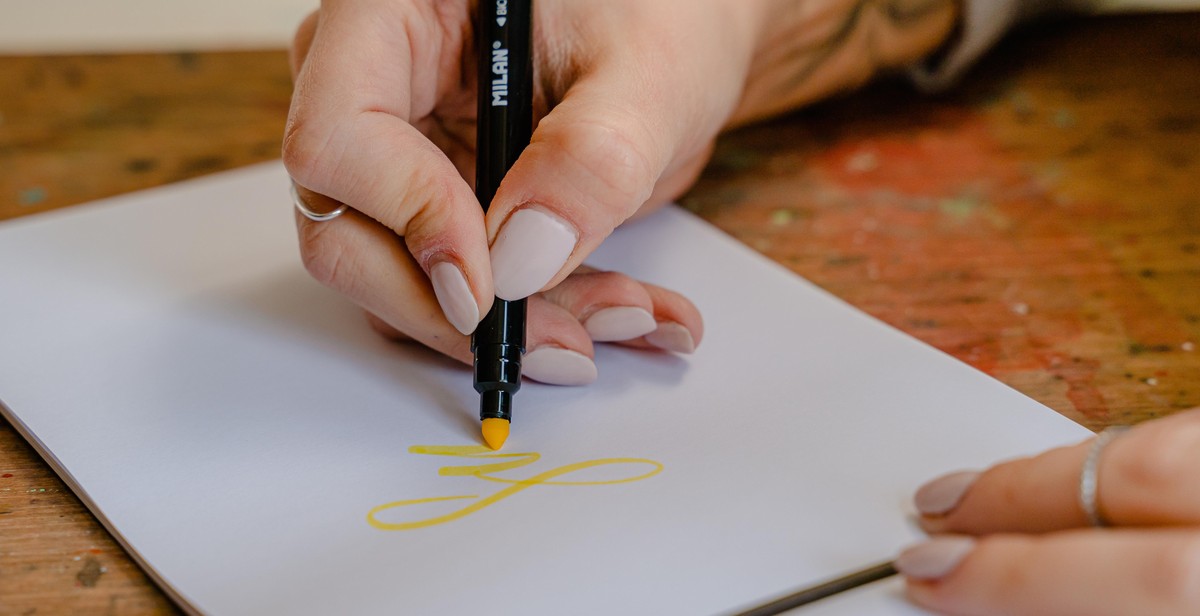How to Master the Art of Hand Lettering
Hand lettering is the art of creating beautiful and unique letterforms by hand. It is a form of calligraphy that involves drawing letters and words by hand, rather than using a pre-made font. Hand lettering is a popular form of art that has been around for centuries and is still widely used today.
What is Hand Lettering?
Hand lettering is the process of creating letterforms by hand using various tools such as pens, markers, and brushes. It involves drawing each letter separately, paying attention to the shape, size, and spacing of each letter. Hand lettering is different from typography, which is the art of arranging pre-made fonts to create a design.
Why Learn Hand Lettering?
Hand lettering is a great way to express your creativity and add a personal touch to your designs. It allows you to create unique letterforms that cannot be replicated by a computer. Hand lettering is also a valuable skill for designers, artists, and anyone interested in creating visually appealing designs. It can be used to create logos, posters, wedding invitations, and much more.
- Hand lettering is a relaxing and therapeutic activity that can help reduce stress and anxiety.
- It is a fun and rewarding hobby that can be enjoyed by people of all ages and skill levels.
- Learning hand lettering can improve your handwriting and overall artistic skills.
If you are interested in learning how to master the art of hand lettering, keep reading for tips and techniques to get started.

Getting Started with Hand Lettering
Hand lettering is an art form that involves drawing letters and words by hand. It’s a popular craft that is used in various industries such as advertising, graphic design, and even wedding invitations. If you’re interested in learning how to master the art of hand lettering, here’s what you need to know:
Supplies You’ll Need
Before you can start hand lettering, you’ll need to gather some supplies. Here are the essentials:
- A pencil
- A pen
- A ruler
- A sketchbook or paper
- An eraser
You may also want to invest in some colored pencils or markers to add some color to your hand lettering.
Understanding Typography
Typography is the art and technique of arranging type to make written language legible, readable, and appealing when displayed. Understanding typography is essential to mastering hand lettering. Here are some typography terms you should know:
| Term | Definition |
|---|---|
| Serif | A small line or stroke that is added to the end of a letter or symbol |
| Sans-serif | Letters or symbols that do not have serifs |
| Kerning | The space between letters or characters |
| Leading | The space between lines of text |
Having a basic understanding of typography will help you create beautiful and legible hand lettering.

Basic Techniques
Hand lettering is a beautiful art form that requires practice and patience. Here are some basic techniques to help you master the art of hand lettering:
Warm-Up Exercises
Before you start lettering, it’s important to warm up your hand and get into the right mindset. Here are some warm-up exercises to try:
- Draw circles and lines to get your hand moving
- Write the alphabet in both uppercase and lowercase
- Practice writing your name in different styles
Strokes and Lines
Strokes and lines are the building blocks of hand lettering. Here are some tips to help you create beautiful strokes and lines:
- Hold your pen at a 45-degree angle for consistent strokes
- Use light pressure for thin strokes and heavy pressure for thick strokes
- Practice creating different types of lines, such as straight, curved, and diagonal
Forming Letters
Once you have mastered strokes and lines, it’s time to start forming letters. Here are some tips to help you create beautifully formed letters:
- Start with simple letters, such as “a” and “o”
- Practice each letter multiple times to get comfortable with its form
- Experiment with different styles, such as serif and sans-serif

Design Principles for Hand Lettering
Hand lettering is an art form that requires a basic understanding of design principles. These principles can help you create visually appealing and effective designs. In this section, we will discuss three essential design principles for hand lettering: composition, hierarchy, and contrast.
Composition
Composition refers to the arrangement of elements in a design. In hand lettering, it is essential to consider the composition of your lettering to ensure that it is visually balanced and appealing. When creating a composition, consider the following:
- The size and placement of each letter
- The spacing between letters and words
- The overall shape and flow of the design
By carefully considering the composition of your hand lettering, you can create a design that is aesthetically pleasing and easy to read.
Hierarchy
Hierarchy refers to the visual arrangement of elements to indicate their importance. In hand lettering, hierarchy is essential to guide the viewer’s eye and convey meaning. When creating hierarchy in your lettering, consider the following:
- The size and weight of each letter
- The use of color or shading
- The placement of emphasis on specific words or phrases
By using hierarchy effectively, you can create a design that communicates your message clearly and effectively.
Contrast
Contrast refers to the differences between elements in a design. In hand lettering, contrast is essential to create visual interest and ensure that the design is easy to read. When creating contrast in your lettering, consider the following:
- The use of different lettering styles or fonts
- The use of color or shading
- The contrast between thick and thin lines
By using contrast effectively, you can create a design that is visually striking and memorable.
| Design Principle | Key Considerations |
|---|---|
| Composition | Size, placement, spacing, shape, flow |
| Hierarchy | Size, weight, color, emphasis |
| Contrast | Style, color, line weight |
Practice Makes Perfect
Hand lettering is a skill that requires practice and dedication. The more you practice, the better you become at it. Here are some tips to help you make the most of your practice sessions:
Daily Practice
Make it a habit to practice hand lettering every day. Even if it’s just for a few minutes, consistent practice will help you improve your skills faster than sporadic practice. Set aside a specific time each day and stick to it. It could be in the morning before you start your day or in the evening before you go to bed.
Challenges
Participating in lettering challenges is a great way to improve your skills and get inspiration. Look for challenges on social media platforms like Instagram or Facebook. These challenges usually have prompts or themes that you can use to create your lettering piece. By participating in challenges, you’ll also get feedback from other lettering enthusiasts, which can be helpful in improving your skills.
Projects
Working on projects is another way to improve your skills and challenge yourself. Start by choosing a project that you’re passionate about, like designing your own wedding invitations or creating a quote poster for your room. This will give you a goal to work towards and help you stay motivated. As you work on your project, you’ll learn new techniques and skills that you can apply to your future lettering projects.
Remember that mastering the art of hand lettering takes time and patience. Don’t get discouraged if you don’t see immediate results. Keep practicing, challenging yourself, and working on projects, and you’ll soon see your skills improve.

Taking Your Hand Lettering to the Next Level
If you’re looking to elevate your hand lettering skills, there are a few techniques you can experiment with to take your work to the next level.
Experimenting with Different Styles
One way to add variety to your hand lettering is by experimenting with different styles. There are countless styles to choose from, including serif, sans serif, script, and decorative, among others. Try out different styles and see which ones you enjoy the most and which ones best suit the message you’re trying to convey.
When experimenting with different styles, it’s important to pay attention to the details. Each style has its own unique characteristics, such as the shape of the letters, the thickness of the strokes, and the spacing between letters. Take the time to study these details and incorporate them into your own work.
Incorporating Illustrations and Embellishments
Another way to take your hand lettering to the next level is by incorporating illustrations and embellishments into your work. This can add visual interest and help to emphasize certain words or phrases.
There are many different types of illustrations and embellishments you can use, such as flowers, leaves, banners, and borders, among others. When incorporating these elements, it’s important to keep them balanced and not overwhelm the lettering itself.
One way to incorporate illustrations and embellishments is by creating a rough sketch of the overall design before starting the final piece. This can help you to plan out the placement of the lettering and the illustrations, ensuring that everything fits together seamlessly.
Overall, experimenting with different styles and incorporating illustrations and embellishments can help take your hand lettering to the next level and make your work stand out. With practice and patience, you can continue to develop your skills and create beautiful, unique pieces of art.

Conclusion
Hand lettering is an art form that requires patience, practice, and dedication. With the right tools, techniques, and mindset, anyone can master the art of hand lettering and create stunning pieces that will impress and inspire others.
Final Thoughts
Remember that hand lettering is not just about creating beautiful letters and words. It’s also about expressing your creativity, telling a story, and conveying a message. Don’t be afraid to experiment with different styles, colors, and designs to find your own unique voice and style.
Also, don’t forget that practice makes perfect. Don’t get discouraged if your first few attempts don’t turn out the way you want them to. Keep practicing, and you’ll eventually develop the skills and confidence needed to create amazing hand-lettered pieces.
SEO Tips
- Include relevant keywords in your hand lettering article to rank higher on search engine results pages.
- Use subheadings to break up your content and make it easier to read.
- Add images and videos to your article to make it more engaging and shareable.
- Link to other high-quality, relevant content to improve your website’s authority and credibility.
Final Words
Mastering the art of hand lettering takes time and effort, but it’s a rewarding and fulfilling experience. Whether you’re a beginner or an experienced artist, there’s always something new to learn and discover in the world of hand lettering. So, keep practicing, keep creating, and keep inspiring others with your beautiful hand-lettered pieces.
